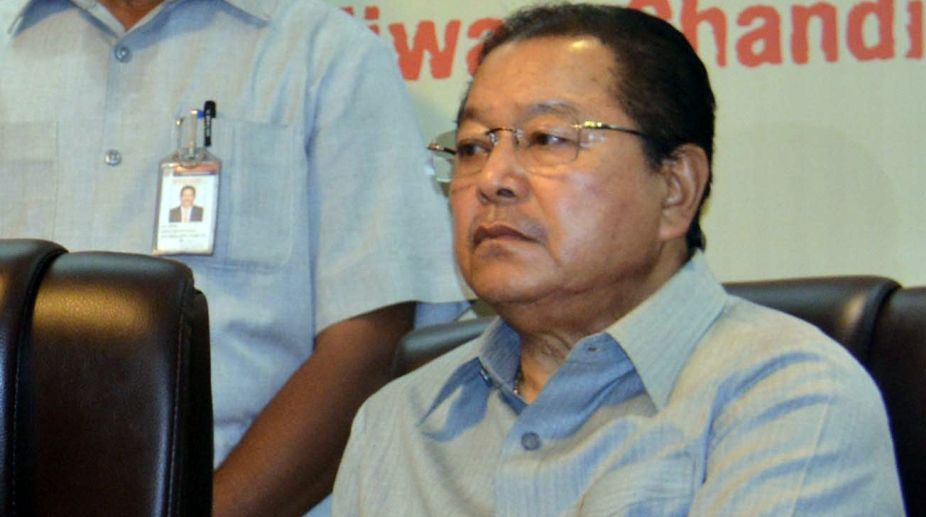PM Modi greets people of Arunachal Pradesh, Mizoram on their Statehood Day
Prime Minister Narendra Modi on Thursday greeted the people of Arunachal Pradesh and Mizoram on their Statehood Day.

Mizoram CM Lal Thanhawla (Photo: IANS)
Though most Northeast states are up in arms against the entry of aliens, Mizoram has a different perception when it comes to its border.
Recently in Aizawl, Union home minister Rajnath Singh held a meeting with the chief ministers of Nagaland (Shurhozelie Liezeitsu), Manipur (N Biren Singh), Arunachal Pradesh (Pema Khandu) and Mizoram (Lal Thanhawla), where the latter was quoted as having said that he was in favour of an “open border” with Myanmar and that the current 16-km free movement of citizens of both countries should be extended to 60 kms.
Advertisement
He said the permit for duration of stay should be 60 days as against the current 72 hours. He also wanted the same arrangement with Bangladesh. At the meeting, Union minister of state for home, Kiren Rijiju was also present.
Advertisement
Mizoram has many illegal immigrants. It has given shelter to thousands of Chakmas from the Chittagong Hill Tracts of Bangladesh. It is worth recall that in 1964 then Prime Minister Jawaharlal Nehru settled hundreds of Chakma refugees on humanitarian grounds after they were displaced following the construction of a dam by the East Pakistan government then.
According to the influential Mizoram student body, Mizo Zirlai Pawl, the Chakma population has gone up from a mere 198 in 1901 to 80,000, as per the 1991 Census. The student body met Rajnath Singh and submitted a memorandum during his visit. It stated that the abnormal rise (150,000) is not possible by way of normal human reproduction and urged the home minister to “look into such a massive influx from outside”. Mizoram has also given shelter to a large number of Chin refugees from Myanmar.
Though there is no official record of their exact number, Chin refugees in the North-east are roughly estimated to be between 50,000 and 100,000 people and is expected to be even more given the constant movement across the border. Interestingly, India does not consider the Chins as refugees and therefore there are no official records of their numbers.
As per the UN High Commission for Refugees’ India office, which records refugees only in Delhi, Chins numbers are around 4,000.
These refugees went to Delhi via Mizoram and Manipur. Delhi “recognises” them as refugees, a status that gives them opportunities for some forms of benefits and facilities. It may be noted that the UNHCR does not, or rather is not allowed to function/operate in Northeast India for reasons best known to Delhi.
Unlike the Chakmas, the Chins have close ethnic affinities with Mizos and therefore they are not considered a “threat” to the local population, though several social issues, such as rape and theft have cropped over the years, at times leading to communal tension between the Chins and Mizos.
Lal Thanhawla favours an open border based on this “close affinity”. He has also argued that an open border will help the growth of trade and business. He feels there is no need for border fencing considering the geoterrain rivers and steep hills that already form a natural barrier.
Lal Thanhawla has categorically argued that the attempt to seal borders has led to a decrease in agricultural land and pastures for people who were dependent on these “no man’s lands” for their livelihood. This, according to the chief minister, is a way of “losing precious lands”. On the other hand, the argument for a closed border is basically for security.
But border fencing in the messy North-east is not as simple or as easy as it seems. Several attempts to fence the border have also created complications and complexities, even opposition. This comes from both the sides.
Mention may be made that early this year, following opposition from Nagas in Nagaland, the border fencing undertaken by the Myanmar government at Pangsha in Tuensang district had to be halted.
Their argument was that Nagas had been, and are living peacefully along the border on both sides; therefore the need for fencing does not arise. They feel that if the border fencing is erected hundreds of villages would be affected and will create tension.
In 2013, the construction of a fence along the 35 kms of the Manipur-Myanmar border in Moreh ran into trouble. It has reportedly been suspended following claims and counter-claims by villagers of both countries.
The unending insurgency is what compels India to consider sealing the border. While in Assam, the All Assam Students’ Union took up the matter, in Manipur the All Manipur Students Union was at the forefront. Agitators in Manipur are demanding reintroduction of the Inner Line Permit System that is presently in vogue only in Arunachal Pradesh, Nagaland and Mizoram.
The existence of several militant groups with their hideouts and bases in Bangladesh and Myanmar, not to forget illegal arms supply from China, calls for sealing of borders. The IndiaMyanmar border is not only vulnerable to insurgency or illegal migrants but also to numerous illegal activities.
The porous borders are an in-famous route for drugs and illegal smuggling of arms. The region has borders with Bangladesh, Bhutan, Myanmar, Nepal and most significantly China. So the Northeast is a “national issue” with an international South-east Asia significance and relevance.
Thus, if India seriously looks towards the East and attempts to promote its Act East Policy with the popular slogan — Northeast is the gateway to South-east Asia — then it should look at the region’s states from the angle of “national interest” rather than limiting its act to a mere “development of the region”.
The writer is an Imphal-based freelance contributor.
Advertisement